Overview
Calcaneal spur is the disease where Calcaneum or the heel bone is met with constant pressure which leads to calcium deposition at the heel part of this bone. If the pressure continues, the deposition takes the shape of a spur or a sharp object, which will lead to pain on standing or while walking. People who need to stand for a long period of time, or those who walk on uneven surfaces are more prone to calcaneal spur.
Plantar fasciitis is one of the most common causes of heel pain. It is caused by inflammation of a thick band of tissue called plantar fascia that runs from the heel bone to the toes.
The main symptom of plantar fasciitis is the stabbing pain that usually occurs with your first steps in the morning. As you get up and move, the pain normally decreases, but it might return after long periods of standing or when you stand up after sitting.
Plantar fasciitis is more common in runners. People who are overweight and those who wear shoes with inadequate support also have an increased risk of plantar fasciitis. In Ayurveda, Vatakandaka is a painful disorder of the heel. Aggravated vata, because of exertion and walking on uneven surfaces takes abode in gulfa sandhi and produces pain.
Symptoms
Common symptoms of vata kandaka are:
- Pain in the heel and surrounding region.
- Excessive and sudden heel pain especially when standing after prolonged sitting or lying down.
- Pain when walking in the morning which reduces as the day goes.
- Increase in heel pain on standing for a long time, running and walking.
Risk Factors
- Excess standing
- Foot deformities
Investigations
The following investigations can be done to confirm diagnosis or know progress of the disease.
- X-ray of the affected joint
Causes
By understanding the causative factor we can make preventive measures for vata kandaka before occurrence of the disease.
Specific causes for Vata kandaka are :
- Walking in irregular or uneven ground.
- Excessive strain on heels.
- Standing or walking for long time.
- Using hard shoes.
- Structural deformity of foot, causing increased pressure on heels.
Common causes of vata increase can also lead to vata kandaka like:
- ativyayama (excessive exercise).
- ativyavaya (excessive sexual activity).
- ati adhyayana (excessive study).
- langhana (fasting).
- plavana (swimming).
- pratarana (falling).
- taking of katu(pungent), tikta (bitter), kasaya (astringent), ruksha (dry), seeta virya (cold potency) foods.
- Excess intake of foods like suska shaka (dry vegetables), vallura (dry meat), mudga (gram), masura (lentil) etc.
- Food habits like anashana (starva- tion), adhyasana (taking meal before the digestion of previous food) etc.
- vegadharana (suppression of urges) like vata (flatus), mutra (urine), purisha (faeces), sukra (se- men), charrdi (vomiting), kshavathu (sneezing), udgara (belching), waspa (tears), etc.
Diagnosis & Treatment
When you consult an Ayurveda physician with symptoms of vatakantaka, they will examine your case in detail. They will inquire about any risk factors in your life and will take a stock of your life to know if you have been knowingly or unknowingly doing any of the causative factors. They will also examine your affected foot to understand more about the degree of progress of arthritis before coming to a decision about the management.
Allopathic management of plantar fasciitis or calcaneal spur include resting, icing the painful area and stretching. Medically pain relievers such as ibuprofen are used for symptomatic relief.
The Ayurvedic approach is holistic, consisting of diet modifications, lifestyle changes, stress management, herbal medication and Ayurvedic therapies, Yoga asanas, pranayama and meditation. All of these together can help the body get back to a state of balance. The approach is effective in a majority of patients.
Medicines for Ayurveda:
Ayurveda has a rich tradition of plant pharmacotherapy with a great variety of anti-arthritic plants believed to reduce inflammation, remove impurities, and balance the doshas that cause arthritis. In Ayurvedic treatment, the selection and dosage of medicines are specific to the patient and will depend on which of the three doshas are out of balance.
Ayurveda Therapies:
Panchakarma: The traditional treatment system to balance doshas involves five therapies: therapeutic vomiting (Vamana), therapeutic purgation (Viechana), medicated enema (vasthi), nasal administration of medicines(nasya), and blood purification(rakta mokshana). If the patient is strong enough to undergo such treatments, they can undergo the ones that are most suitable for them.
Ayurvedic treatment for any disease is much more than panchakarma. It also includes herbal medicines, medicated oil therapies, and analgesic pastes.
Special therapies for vata kandakam / calcaneal spur:
- Ishtika swedam : Sudation of feet with hot brick.
- Agni Karmam : Cauterization of affected area.
- Swedana : Sudation procedures like Valuka (sand) sweda can also relieve tha pain due to vata kandakam.
Diet :
A light vegetarian diet is recommended, with avoidance of foods known to increase vata, like gassy vegetables like potatoes, peas etc.
Lifestyle:
Feet should be rested well until completely healed.,Smooth and lightweight footwear are better for those with vata kandakam / calcaneal spur. Warm water bath after a long walk is good to rest your feet.
Ayurveda offers a holistic, historically rooted, reportedly safe, alternative treatment for Arthritis.
At Saranya, we believe in the old school application of Ayurveda wisdom with a modern approach rooted in evidence based practise. The medicines and therapies are fixed only after individual consultation through listening, understanding the need and analyzing the root cause. We incorporate different diagnostic methodologies in identifying the root cause of pain and plan unique customized treatment strategies to eliminate the causes.
We believe in restoring the quality of life by relieving the hardships and pain of those who suffer from arthritis.
References: Ashtanga Hridaya, Charaka Samhita, Sushrutha Samhita.


